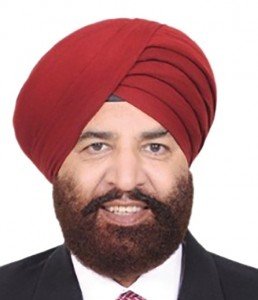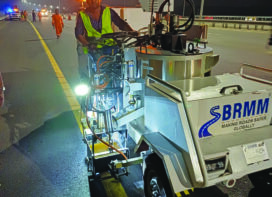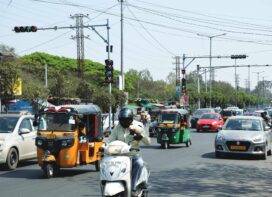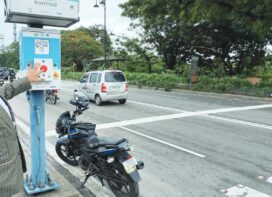World over new technologies are being adopted for over-speeding and red light violation. Laser-based equipment is one of the technology to combat erring drivers, and reduce accidents and fatalities on the roads.
Enforcement of speed and red light is a big challenge not only in India but also in other parts of the world. Many new technologies are being adopted by the concerned authorities to reduce the accidents. There are various types of devices which are used for the enforcement viz. Safety camera, Speed camera, Red Light Enforcement Cameras along with Automatic Number Plate Recognition (ANPR) software. These devices are either being used as hand held or tripod mounted and also as fixed installations by the side of the roads or on cantilever poles.
There are mobile Interceptor vehicles which are also used for the Speed and other traffic violation enforcement. These vehicles are equipped with Laser/Lidar device along with camera and recorder with a facility to record the violation in day as well as in night time. The range of number plate capturing with good picture quality at day time is around 100-120 meters whereas at night it is around 25-40 metres. These days very compact units are being used which are light in weight and easy to operate. These devices also have printing facilities to print the challan/ticket to the traffic violator, there and then (on the spot). There are some devices with the facilities of GPS and GPRS which can send the captured number plate along with speed, time, date and location of the traffic violation to a distance of around 500 meters to 1000 meters or more away from the actual spot of violation. By this method,
we do not have to stop the violating vehicle which is at a high speed at the site of violation capturing. These are relayed to a distance of around one kilometre and there the vehicle is stopped with a proper barricading. This avoids un-warranted accidents to stop the violator.
Another way of issuing the challans is the `Electronic Way’. In this case, the vehicles are not stopped but their violation challans/tickets are made on the basis of the information fetched from the central server of the traffic/ transport department regarding the ownership data.
Laser Technology Inc, one of the leaders in manufacturing such devices, is based in Colorado, Denver, USA. They have a product well known in the international market as TruCam which does all the operations as mentioned above. The Unit is very compact and has built in camera, laser, recording on SD Card, LCD and battery for 15hrs . This product has been sold throughout India in very good numbers and is being used and appreciated by the users.
As far as fixed type speed Violation Cameras are concerned, there are two types made available by the manufacturers – one detects the speed of the vehicles by using Radar, Laser or inductive loops. Although the best way to find out the exact speed is by using inductive loops, cutting of loops on the road and wear & tear of the roads make it cumbersome. Mega pixel cameras are used to take pictures of the speeding vehicles from more than one lane, may be upto four lanes. Some companies use one camera for each lane depending
on the situation and the site and traffic requirements. The feature of red light enforcement is also included in some of the camera. It is taken as a violation when any vehicle is crossing the `Stop Line’ once the light is red. All the data from the violation is recorded at the site which can be downloaded at a Central Control Room through PSTN lines Fibre Optic cable or GPRS, wireless automatically, scheduled or manually. The challans are generated at the control room after capturing the violation through ANPR and fetching ownership data from the traffic/ transport server. These technologies are very useful to combat erring drivers and thus reducing accidents and fatalities on the roads.
Iqbal Singh Jagdeva
Managing Director
Turbo Consultancy Services Pvt Ltd
 TrafficInfraTech Magazine Linking People Places & Progress
TrafficInfraTech Magazine Linking People Places & Progress



